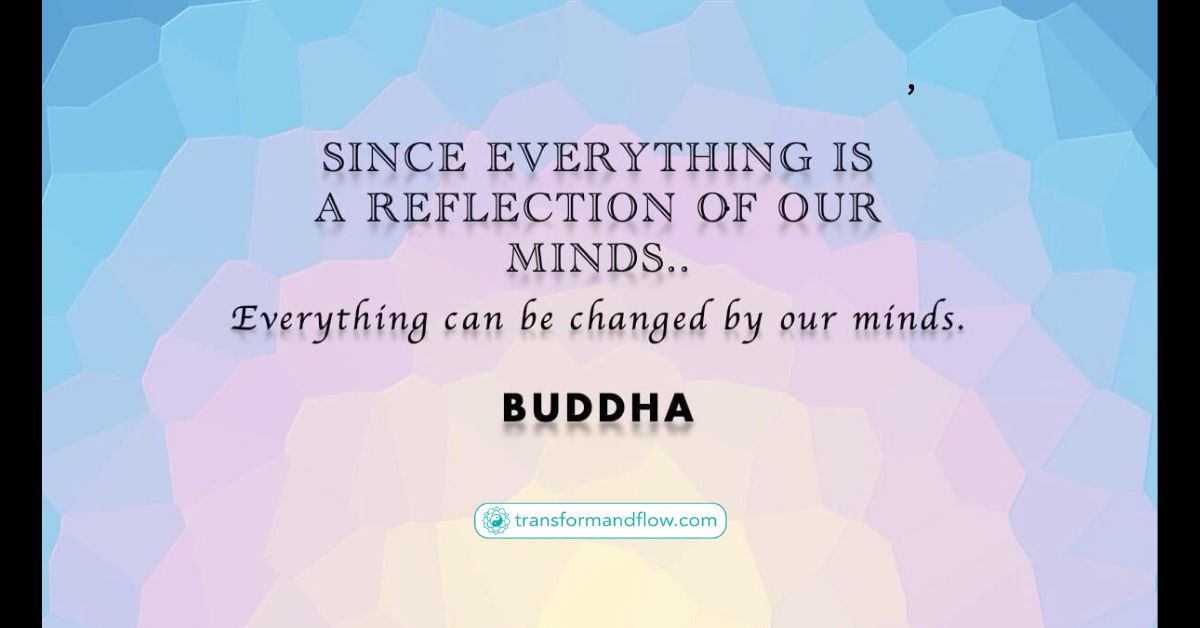Since everything is a reflection of our minds… everything can be changed by our minds.– Buddha
This powerful quote from Buddha captures one of the most profound truths of human existence: our reality is not simply a product of the external world, but a mirror of our internal world.
The way we interpret life’s events, respond to challenges, and define success, failure, happiness, or suffering all stem from the patterns and perceptions housed within our own minds.
And here lies the beauty of this truth: if our reality is shaped by our minds, then by changing our minds, we can transform our experience of life.
Let’s explore what this really means and how it can practically change your life.
The World Is Not What It Is, It’s What You Think It Is
Two people can go through the same situation and come away with completely different experiences. One might feel defeated, while the other feels empowered. The only difference? Their mindset. Buddha’s words encourage us to look inward first when facing the realities of life. The events outside of us are often neutral until we attach a meaning to them, and that meaning comes from within.
Take, for instance, a missed opportunity. Someone might see it as a sign of failure and spiral into self-doubt. Another might interpret it as redirection – an opportunity to grow or refine their path. It’s not the event that defines the outcome, but the mental interpretation of that event.
By developing awareness and shifting thought patterns, people often experience profound changes in how they feel and interact with the world.
How Mindset Shifts Create Real-World Change
If everything can be changed by our minds, what does that look like in action?
Let’s look at a classic example: Viktor Frankl, psychiatrist and Holocaust survivor, wrote extensively in Man’s Search for Meaning about how the ability to choose one’s attitude in any given set of circumstances is a powerful freedom. Even in the darkest of human experiences, he found that those who could assign meaning and hope to their suffering fared far better emotionally than those who lost their sense of purpose.
This isn’t to say that we can “think away” real-world problems. But what we can do is radically alter how we show up in the face of them. When we cultivate awareness and mastery of the mind, we gain the ability to respond instead of react, to create rather than simply cope.
Neuroplasticity: The Science Behind Mental Change
Modern neuroscience supports Buddha’s ancient wisdom. The concept of neuroplasticity shows that the brain is malleable. It can rewire itself based on thoughts, behaviors, and experiences. This means that our mental habits are not fixed; we can literally train our brain to see, think, and feel differently.
For example, consistent mindfulness practices like meditation have been shown to shrink the amygdala (the brain’s fear center) and strengthen the prefrontal cortex, which governs rational thought and decision-making. Studies from Harvard and other leading institutions confirm that meditation and intention-based practices lead to measurable, positive changes in brain structure and function.
The Neuroscience of Meditation – Calm.com
The Mirror of Relationships
One of the most direct ways we see the reflection of our minds is through relationships. People around us often reflect back what we most need to see in ourselves. If we constantly feel disrespected, unloved, or undervalued, it may be a sign to look inward. Do we respect ourselves? Do we feel worthy of love? Are we clear about our boundaries and values?
It’s not about blaming ourselves for others’ behavior, but rather about recognizing the power we hold in shaping how we engage with others. When we shift our internal dialogue and self-perception, our relationships often begin to shift as well, and in the prococess they either improve or reveal misalignments that we previously tolerated.
The Role of Intention and Visualization
One of the most practical ways to work with the power of the mind is through intention setting and visualization. Athletes, CEOs, and performers often use mental imagery to prepare for high-stakes moments. They “see” success before it happens activating the same parts of the brain that light up when they’re actually performing the task.
Visualization is not just daydreaming. When coupled with emotional alignment and consistent action, it becomes a powerful creative force. Why? Because the subconscious mind begins to rewire itself to match the new image. Over time, we begin to act in ways that align with that mental picture, changing our external reality in the process.
Read more here The Difference Between Visualization and Vision: Two Pillars of Purposeful Living
Shifting Perception to Heal the Past
Even our memories, those sacred records of who we think we are, are subject to the influence of the mind. Two people may remember the same childhood event in vastly different ways. Even within ourselves, as we grow and evolve, the way we interpret past experiences can shift dramatically.
Through practices such as inner child healing, journaling, therapy, or guided hypnotherapy, we can revisit painful past events not to relive them, but to reframe them. Often, the stories we tell ourselves about the past are more damaging than the actual event.
Changing our perception of the past doesn’t mean denying what happened – it means choosing a narrative that empowers rather than imprisons us.
Six Everyday Practices to Change Your Reality Through Your Mind
- Start a Morning Intentions Practice
- Spend five minutes each morning setting a clear emotional or mental intention for the day. This primes the subconscious to seek and create that experience.
- Pause and Breathe Before Reacting
- When triggered, take three deep breaths. This small act can shift you out of reactivity and into conscious response.
- Challenge a Limiting Belief Daily
- Catch one self-limiting thought and reframe it. For example, “I’m not good at public speaking” becomes “I’m learning to express myself confidently.”
- Meditate Regularly
- Even 10 minutes a day of simply sitting quietly and focusing on the breath can drastically improve awareness and emotional regulation.
- Use Visualization
- Before tackling a challenge, close your eyes and visualize yourself succeeding.
- Note that some people see and some people just know, so it’s OK if you are not able to visualize in images.
- Feel it in your body. This mental rehearsal aligns your energy with your goals.
- Surround Yourself with Empowering Inputs
- Books, podcasts, people, and environments that reflect the mindset you aspire to will naturally reinforce your desired internal world.
Conclusion: Your Mind Is the Paintbrush of Reality
Buddha’s wisdom reminds us that transformation doesn’t begin in the external world – it begins in the mind. If everything is a reflection of your thoughts, emotions, and beliefs, then your mind becomes the ultimate creative force.
You don’t have to be perfect. You don’t have to have it all figured out. You simply have to start by becoming aware. Choose one thought today that serves your highest self, and from that single thought, begin to build a new reality.
Because the truth is: you are not powerless. You are the painter, the canvas, and the masterpiece all in one. And when your inner world begins to change, the outer world has no choice but to follow.


